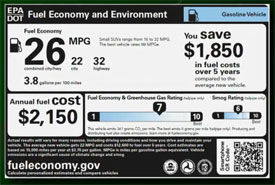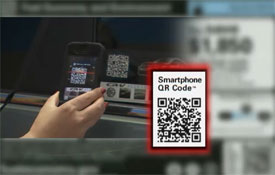New Fuel Economy Labels
The US Department of Transportation and the Environmental Protection Agency have revamped their fuel economy labels for all 2013 model year vehicles making them even more comprehensive for consumers.
It’s going to take some time for car shoppers to digest all the information on the new fuel economy and environment labels, but federal agencies hope it will help consumers make more informed decisions about which car is right for them.
 The first thing a customer will notice on the label affixed to a gasoline or diesel vehicle is a single large number for the combined fuel economy rating. This mix of city and highway ratings is deemed a more realistic measure of the mileage a vehicle can achieve in routine driving; the city and highway ratings are still listed, but in much smaller type. Also in smaller type is how many gallons should be needed to go 100 miles.
The first thing a customer will notice on the label affixed to a gasoline or diesel vehicle is a single large number for the combined fuel economy rating. This mix of city and highway ratings is deemed a more realistic measure of the mileage a vehicle can achieve in routine driving; the city and highway ratings are still listed, but in much smaller type. Also in smaller type is how many gallons should be needed to go 100 miles.
Across from the combined city/highway mpg is a five year estimate of fuel savings. It shows how much this vehicle might save in fuel cost compared to the average new vehicle’s mpg.
Total annual fuel cost is also listed, along with greenhouse gas and smog tailpipe emissions.
 And for on-the-go shoppers, comparing the fuel economy of the newest vehicles is now at your fingertips. With the help of your smart phone, you can simply scan the qr code listed on the window label to get mileage estimates and pertinent information on to a specific vehicle and others. You can also customize information based on your driving habits.
And for on-the-go shoppers, comparing the fuel economy of the newest vehicles is now at your fingertips. With the help of your smart phone, you can simply scan the qr code listed on the window label to get mileage estimates and pertinent information on to a specific vehicle and others. You can also customize information based on your driving habits.
There are actually multiple types of fuel economy and environment labels now depending on a car’s powertrain. Plug-in electric hybrid vehicles provide a combined fuel economy rating based on electricity use, stated in mpg-equivalents and, in straight miles-per-gallon when running on gasoline alone. One purpose of the label update is to make it easier for consumers to compare across all types of vehicles.
Likewise, pure electric cars get their combined rating in mpg-e as well, along with how many kilowatt hours of electricity are needed to travel 100 miles.
And some vehicles are arriving at dealers right now with the updated labels. For more information, simply visit the government’s fuel economy website.





